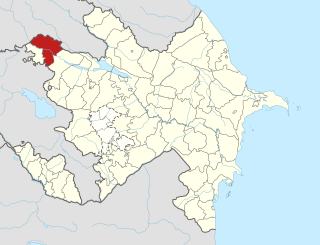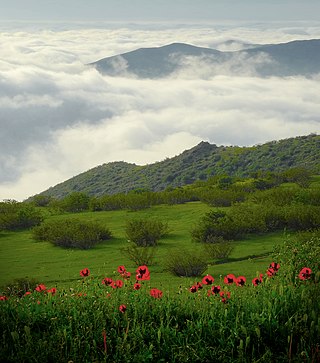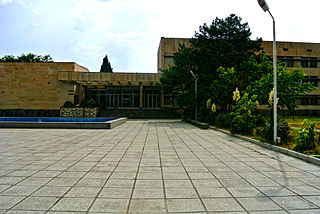
Aghstafa District is one of the 66 districts of Azerbaijan. It is located in the north-west of the country and belongs to the Gazakh-Tovuz Economic Region. The district borders the districts of Qazakh, Tovuz, as well as the Kakheti and Kvemo Kartli regions of Georgia. Its capital and largest city is Aghstafa. As of 2020, the district had a population of 88,500.

Shamkir District is one of the 66 districts of Azerbaijan. It is located in the north-west of the country and belongs to the Gazakh-Tovuz Economic Region. The district borders the districts of Gadabay, Tovuz, Samukh, Goygol, and Dashkasan. Its capital and largest city is Shamkir. As of 2020, the district had a population of 219,500.

Yevlakh District is one of the 66 districts of Azerbaijan. It is located in the centre of the country and belongs to the Central Aran Economic Region. The district borders the districts of Qakh, Shaki, Agdash, Barda, Tartar, Goranboy, and Samukh. Its capital and largest city is Yevlakh. As of 2020, the district had a population of 129,700.

Gardabani is a city of 11,650 residents (2021) in the southern Georgian region of Kvemo Kartli and is the administrative centre of the Gardabani Municipality. It is located 34 kilometres (21 mi) southeast of capital Tbilisi and 10 kilometres (6.2 mi) from Rustavi in the Kvemo Kartli Plain at an elevation of 300 metres (980 ft) above sea level. Until 1947 Gardabani was known as Karayazi and the city status was granted in 1969, after a thermal power plant was built for Tbilisi in the 1960s causing rapid growth. Since then more plower plants have been built and the city nowadays supplies almost all thermally generated electricity in the country.

Chile's total primary energy supply (TPES) was 36.10 Mtoe in 2014. Energy in Chile is dominated by fossil fuels, with coal, oil and gas accounting for 73.4% of the total primary energy. Biofuels and waste account for another 20.5% of primary energy supply, with the rest sourced from hydro and other renewables.

The Mingachevir Dam is an earth-fill embankment dam on the Kura River just north of Mingachevir in Azerbaijan. It serves several purposes to include hydroelectric power production and water storage for irrigation. The Mingachevir reservoir, behind the dam, supplies water to the Upper Qarabag and Upper Sirvan Channels which help irrigate about 1,000,000 ha of farmland in the country. Its six Francis turbine-generators were overhauled or replaced with 70 megawatts (94,000 hp) sets in 2000. Mingachevir reservoir has a storage capacity of 15.730 cubic kilometres (12,753,000 acre⋅ft), covering 605 km2 (234 sq mi). The length of the dam is 1,550 metres (5,090 ft), its width is 16 metres (52 ft) and height is 80 m (260 ft). It is the largest hydroelectric power station in the South Caucasus, is located over Kur river and not far from Mingachevir city.
The Shamkir Hydro Power Plant is one of Azerbaijan's largest hydro power plants having an installed electric capacity of 380 megawatts (510,000 hp). It is located on Shamkir reservoir in Shamkir Rayon of Azerbaijan, and is owned by Azerenerji.
Two-thirds of energy in Azerbaijan comes from fossil gas and almost a third from oil. Azerbaijan is a major producer of oil and gas, much of which is exported. Most electricity is generated by gas-fired power plants.

The Ministry of Energy of Azerbaijan Republic is a governmental agency within the Cabinet of Azerbaijan in charge of regulating the activities in the industry production and energy sector of Azerbaijan Republic. The ministry is headed by Parviz Shahbazov.
Energy in Serbia describes energy and electricity production, consumption and import in Serbia.

The Zhikong Hydro Power Station, is a reservoir and power station on the Lhasa River in Maizhokunggar County to the east of Lhasa, Tibet, China. It came into operation in 2007, and has a capacity of 100 MW.

The electricity sector of Armenia includes several companies engaged in electricity generation and distribution. Generation is carried out by multiple companies both state-owned and private. In 2020 less than a quarter of energy in Armenia was electricity.
The climate in most parts of Azerbaijan is semi-arid. In order to expand the areas of irrigation in a dry climate and to provide grape and orchards with water, many small and large reservoirs have been created. There are 140 reservoirs in the country. The total volume of reservoirs is 21.5 km3. Most reservoirs are regulated and used for irrigation. Reservoirs and hydroelectric stations created in the rivers Kura, Araz and Tartar are Shamkir, Mingachevir, Yenikend, Varvara, Araz and Sarsang. They are used to ensure the use of energy, irrigation and water supply.

Utilities in Azerbaijan cover the topic of public utility services in the territory of Azerbaijani Republic. The utilities of Azerbaijan are provided by the government owned public utilities: “Azersu” for the water supply and waste management, “Azerishiq” and “Azerenerji” for electricity, “Azerigaz” for natural gas, “Azeristiliktechizat” for district heating.

Azerishiq is the Baku electrical grid operator.

The power generation potential of the rivers in Azerbaijan is estimated at 40 billion kilowatt per hour, and feasible potential is 16 billion kilowatt per hour. Small-scale hydro has significant developmental potential in Azerbaijan. In particular, the lower reaches of the Kura river, the Aras river and other rivers flowing into the Caspian Sea. Hydropower could conceivably provide up to 30% of Azerbaijan’s electricity requirements. Currently, hydropower, dominated by large-scale dams, provides 11.4% of Azerbaijan’s electricity.

Deportation of Azerbaijanis from Armenia – is the resettlement of the Azerbaijani population of the Armenian SSR in 1947-1950, which was carried out in accordance with the Decree of the Council of Ministers of the USSR No. 4083 dated with 23 December 1947.
Sanan Samandar oghlu Akhundov is an Azerbaijani statesman, head of the Azerbaijan State Standardization and Metrology Center, Permanent Representative of the Azerbaijan SSR Council of Ministers to the USSR Council of Ministers (1987–1989), Minister of Local Industry of the Azerbaijan SSR (1982–1987).














